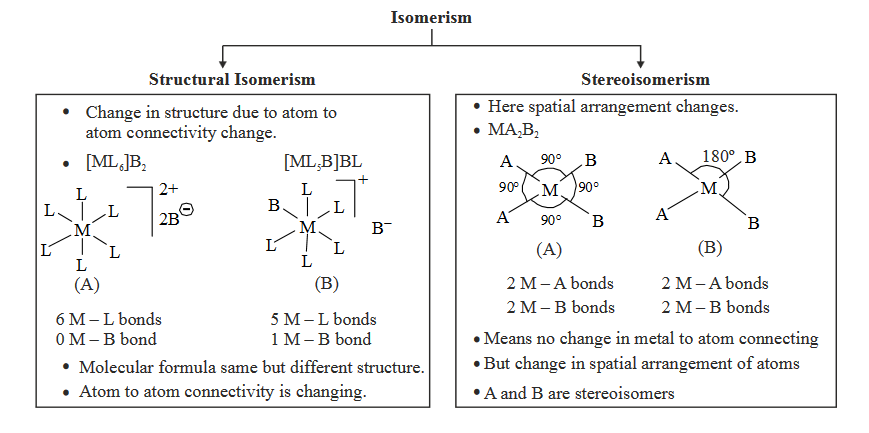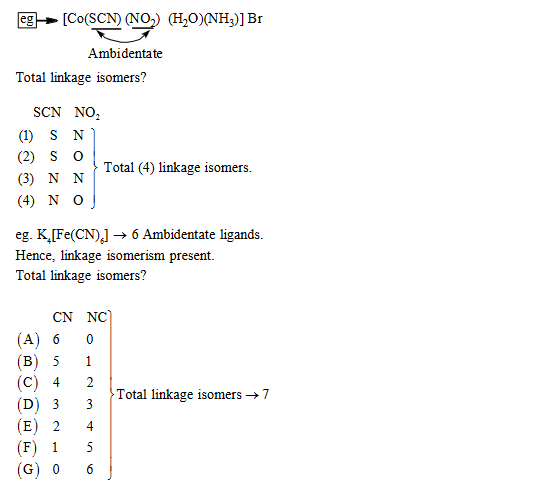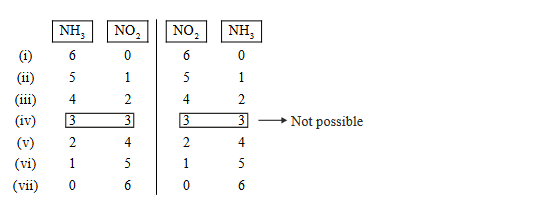Isomerism in Coordination Compounds
- Compounds which have the same molecular formula, but differ in their properties due to the difference in structure are called as isomers.
- Isomerism is commonly considered to the haracteristic of only organic compounds, it is also found although less frequently among inorganic substances.
Types of isomerism
(A) STRUCTURAL ISOMERISM : Structural isomer is also called a constitutional isomer. Struc- tural isomers are those isomers in which the atoms are completely arranged in a different order with same molecular formula.
(B) STEREO ISOMERISM : Stereo isomerism is exhibited by those compound which have the same position of atoms or groups but these atoms or groups have different spatial arrangement around the centre atom. The compound showing stereo isomerism are called stereo isomers.

|
|
Structural Isomerism
Compound with the same formula, but give different ions upon disso- ciation, exhibit ionization isomerization. The difference is in which ion is included as ligand and which is present to balance the over all charge.
 Point to remember: ligand exchange between coordination sphere and ionisation sphere.
Exchange of ligands do not depend upon the charge. It depends upon the denticity of the ligand. SO4 and Br both are monodentate ligands.
Point to remember: ligand exchange between coordination sphere and ionisation sphere.
Exchange of ligands do not depend upon the charge. It depends upon the denticity of the ligand. SO4 and Br both are monodentate ligands.•Coordination sphere should have some charge to show some interactions with the ionisation sphere.
 Again result in overall zero charge on coordination sphere. Hence molecular formula changes.
Again result in overall zero charge on coordination sphere. Hence molecular formula changes. - Hydration isomerism requires water to play two roles as : As a ligand
- An additional occupant (or solvate) within the crystal structure Solvent isomerism broadens the defination to allow for the possibility of ammonia or order ligand participating as solvates. CrCl3.6H2O is a classic example.
[Cr(H2O)4Cl2]Cl2.2H2O (Dark Green)
[Cr(H2O)5Cl]Cl2.H2O (Blue Green)
[Cr(H2O)3Cl]Cl3.3H2O
And, we know isomers have same molecular formula but different structure. This is how (iv) will not be the hydration isomer of (i), (ii) and (iii).
Point to remember: Ligand exchange between coordination sphere and ionisation sphere. It must be water.
In some ligands, like ambidentate ligands, there are two possible coordination sites. In such cases, linkage isomerism exist. e.g., NO2 group can be bonded to metal ions through nitrogen (– NO2) or through oxygen (–ONO). SCN too can be bonded through sulphur (–SCN) thiocyanate or through nitrogen (–NCS) isothiocyanate.
Point to remember: Compound must has at least one ambidentate ligand

Example: [Cr(NH3)6][Co(NO2)6](A), [Cr(NH3)5(NO2)][Co(NO2)5(NH3)](B)
(A) and (B) are coordination isomers of each other. All the other possible isomers are given below.

Case: (iv) is not possible because in this case ionic interactions are not possible. Both these complexes will be different and molecular formula change.
Polynuclear coordination compounds having same molecular formula and same number of co-ordinating groups and are distributed in a different way around the metal ions are called coordi- nation position isomers. Point to remember : Ligands exchanged in bridging compounds.

They both are coordination position isomers
Ligand isomerism is a type of structural isomerism which arises from the presence of ligands which can adopt different isomeric forms. 1, 2 diaminopropane and 1,3 diaminopropane are the examples that feature a different isomers would be ligand isomers.
Since many ligands are organic compounds which have possibilities for isomerism, the result- ing complexes can show isomerism from this source.
Point to remember: Atom to atom connectivity is changing due to ligand
For example: [M(pn)3] and [M(tn)3] are ligand isomers of each other where (pn) and (tn) have same molecular formula.

Considered to be a special case of coordination isomerism, in this the various isomers differ in formula weight from one another, so not true isomers in real sense.

Stereo Isomerism:
The complex compounds which have the same ligands in co-ordination sphere but the relative position of the ligand around the central atom is different are called geometrical isomers and the phenomenon is called geometrical isomerism.
When two identical ligands are coordinated to the metal ion from same side then it is known as cis isomers.
When two identical ligands are coordinated to the metal ion from opposite side then it is trans isomers. Geometrical isomerism is much important in compounds with coordination number 4 and 6. Four coordinated complexes with tetrahedral geometry do-not exhibit cis trans isomer-ism.

A co-ordination compound which can rotate the plane of polarised light is said to be optically active.
When the co-ordination compounds have the same formula but differs in their ability to rotate direction of the plane polarised light are said to exhibit optical isomerism and the molecules are optical isomers.
Optical isomers are mirror image that cannot be superimposed on the another. These are called as enantiomers. The molecules or ions that cannot be superimposed are called chiral. This is due to absence of elements of symmetry in the complex. The two forms are called dextro (d) and leavo (l) depending upon the direction they rotate the plane-polarised light. Only those 6 coordinated complexs in which there are chelating agents i.e., bidenate ligands, exhibit optical isomerism. This is due to the absence of elements of symmetry in the complex. Optical isomerism is not found in square planar complexes on the account of the presence of axis of symmetry.

(1) Tetrahedral Geometry:
In tetrahedral geometry since bond angle is always 109°28. Bond angle will remain same as on changing the ligands.
 Therefore, Geometrical isomers do not exist.
Therefore, Geometrical isomers do not exist.Lets generate cases for monodentate.
In this case plane of symmetry exists and hence the complex will become optically inactive and a complex should be optically active to have mirror image and enantiomeric pair.
Hence, in this case no enantiomeric pair exist.

Therefore, optically inactive. Hence, no enantiomeric pair exist because no mirror image exist.
(2) MA3B
In this molecular formula 2 types of complexes can exist by changing the positions of the ligand.
In 1st plane of symmetry (POS) exists. Hence, it is optically inactive.
And therefore, no enantiomeric pair possible.
In 2nd also plane of symmetry exist and hence it will also become optically inactive.
Here, No enantiomeric pair exist because no non-superimposable mirror image is possible.






